-
Články
Top novinky
Reklama- Vzdělávání
- Časopisy
Top články
Nové číslo
- Témata
Top novinky
Reklama- Kongresy
- Videa
- Podcasty
Nové podcasty
Reklama- Kariéra
Doporučené pozice
Reklama- Praxe
Top novinky
ReklamaAssessment of the injuring effect of loose objects in a vehicle in a traffic accident
Authors: Jaroslav Hrubý 1; Zdeněk Krobot 2
Authors place of work: Ústav soudního inženýrství VUT Brno 1; Univerzita obrany, Katedra Bojových a speciálních vozidel, Brno 2
Published in the journal: Úraz chir. 26., 2018, č.3
Summary
The aim of the work is to describe the mechanism of injury of the human head (vertex) in the interaction with freely moving objects and to determine the limit values of the speed for a particular object at a given momentum, when the injury occurs. The experimental measurement method simulates the real biomechanical load of the human organism (in the form of a human head), which is demonstrated on the Hybrid III crash test dummy. Evaluation of the biomechanical load of the head is based on the calculation of the criterion, which is a function of the maximum acceleration of the crash test dummy‘s head interacting with a freely moving object (impactor). For a particular object of a given weight, there are equations of the trend of exponential development of the risk of injury, depending on the increasing velocity of the moving object.
Keywords:
Head Injury Criterion – Head injury – Critical Speed – traffic accident
Aim of the work
What are the critical speeds of a free-flying object necessary to injure and kill an adult at a deceleration of a vehicle due to an impact with an obstacle. What is the injuring trend with increasing speed of a free-flying object and hence the speed of impact of a vehicle with an obstacle.
Type of work: Study.
This study is aimed at investigating the injuring effect of loose objects in a vehicle when interacting with the human body under decelerating due to heavy braking or a collision with another object. Momentum of loose objects or the time effect of the action of the force of these objects at an impact can be relatively easily calculated. However, to quantify the injuring effect caused by a free-flying object upon interacting with parts of the human body is a much more complex task. The cause of deceleration causing release of loose objects is the stopping of the vehicle from a certain speed v1 to a speed v2 over a very short path. In the event of a collision with a fixed obstacle, the v2 speed may be considered equal to zero.
Injuries by flying objects can be related to the entire human body, but there are places where an injury caused by interaction with a flying object may have fatal consequences with respect to human life or subsequent life (so-called traumas). The main question is at what speed (of the object or/and the vehicle) the object can cause injury or death. It should be noted that killing or injury must always be related to a particular part of the human organism. The research that has been conducted is focused on the area of the head, or its vertex part.
The subject of the research is to describe in a systematic manner the behaviour of a freely loaded object at a car‘s rapid deceleration - application to the interaction of an object with a human organism with a focus on the rear/top of the head.
There are many ways in which the problem of determining the risk of injury to the heads of the crew by interaction with a released flying object can be addressed. The solution can be a calculation using a specialized computing program or a realistic experiment with adequate equipment for its implementation.
The calculation using specialized software is favoured by its adaptability with regard to the parameterization of the model that enters its own calculation - refers to the needs of the calculation. The disadvantage of this approach is the accuracy of the model, which should be „tuned“ depending on the results of experimental measurements.
Brief introduction to experimental measurement
The experiment simulates the real biomechanical burden of the human organism (in our case, the human head model) resulting from the impact of a free-flying object. The movement of the object in real traffic is caused by a sudden braking maneuver of the car or its collision with a barrier.
A pneumatic cannon was used in the experiment to achieve the corresponding impact on the rear/top of the head of the Hybrid III crash test dummy. For example, the application of the pneumatic cannon is usually carried out as part of tests of resistance of aircraft structure to an impact of a flying object (e.g. a bird) in the range of weights of 0.5 to 4 kg with flight speeds ranging from 100 to 999 km.h-1. Impact scanning is provided by high-speed cameras. The barrel of a pneumatic gun is made of a smooth seamless steel tube and has a caliber of 125 mm. The barrel length is about 1 m. The muzzle velocity is measured by an optical system.
The essential advantage of the advantage of the load induced by the pneumatic cannon is the repeatability of the tests. There is hardly any wear on the individual parts of the measuring chain, and the test is ultimately very easy to implement for both initial and subsequent measurements when adopting basic measurement approach.
Evaluation of the biomechanical load of the head is based on the calculation of the HIC criterion (Head Injury Criterion), which is a function of the maximum resulting head and time acceleration when interacting with a flying object. The evaluation depends on the length of time the effect of acceleration and its magnitude. The HIC criterion for 36 ms, 15 ms and the so-called HIC (d) criterion is considered for the evaluation of the experiment.
The HIC criterion for the 15 ms and 36 ms time frames is calculated as follows:
where:
a - is the resulting acceleration acting on the human head,
ax, ay, az - are the acceleration components acting on the human head, t1, t2 - is the start and end of the time frame of action of the acceleration action on the human head.
The value of the HIC(d) criterion is calculated from the HIC criterion for the time section of 36 ms, and it is a maximum standardized value of the head acceleration integral [2]:
The value of HIC criterion equal to 1000 according to SAE standards and the value of 250 according to military standard AEP-55 is evaluated as the limit value. The value of 1000 represents a load where human brain damage can occur, a value of 250 represents a loss of concentration and significantly influences the orientation and concentration of a person.
To achieve adequate results in a real experiment, it is necessary to ensure the following conditions:
- Application of measuring apparatus with sufficiently high accuracy of data collection (we can imagine application of sampling frequency 10 kHz under the term of high accuracy - it is a monitoring of an impulse phenomenon).
- Application of a realistic human biomechanical model (Hybrid III crash test dummy, specially designed for human biomechanical load measurement).
- Creating and debugging of load equipment and means of activation.
- Application of appropriate evaluation software with the necessary specialized computing modules.
The experiment was carried out for nine cases where we operate the Hybrid III carsh test dummy head with different stiffnesses (3 cases - soft rubber; hard rubber; PET bottle) and different weights (3 cases - 0.5 kg; 1 kg; 1.5 kg). The weight aspect is clearly defined. The stiffness aspect is to simulate three cases of objects that can normally be freely laid in a vehicle. It is a PET bottle full of liquid, a solid object such as a radio, and then a soft object with the possibility of reversible deformation (e.g. a piece of rubber).
The aim of the experimental measurement itself is to carry out the Hybrid III crash test dummy head tests to describe the critical response of the dummy head to the various impact load conditions. Hybrid III dummy head load cases have been triggered by projectiles of varying stiffness moving and interacting with the Hybrid III dummy head with different speed parameters (different kinetic energies).
The critical response of the Hybrid III crash test dummy head is described by the so-called HIC criterion. The HIC criterion describes the degree of head injury risk arising from the head impact load.
The HIC criterion is calculated from the acceleration measured by piezoelectric accelerometers placed in the centre of gravity of the Hybrid III crash test dummy.
Fig. 1. Schematic representation of the experimental sub-steps to determine its goal 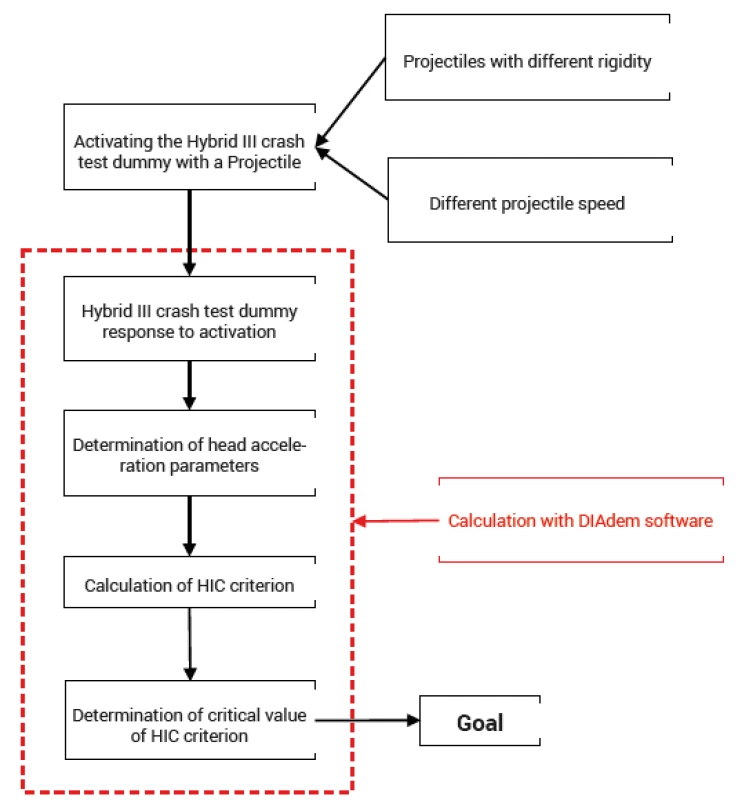
Description of projectiles
The projectile makes part of the measuring chain that serves as an impactor (that is, a part impacting the head). The projectile itself is of three versions with different rigidity:
- Rigid projectile.
- Soft projectile.
- Projectile simulating a PET bottle.
The rigid projectile is characterized by an ending that is made of a hard „non-deformable“ rubber. The rubber has the same rigidity as a rubber stick – see graph 1.
The soft projectile is made up of a very soft rubber that has the property of returning to its position after loading and deformation - see graph 1.
Graph 1. Comparison of stiffness of individual tips (hard rubber - TP; soft rubber - MP; PET bottle - PET) 
The projectile simulating a PET bottle has a PET bottle tip. This tip has the property that it deforms (and remains in the deformed state) compared to the two previous tips and is subject to creating cracks in case of high impact velocity – see graph 1.
The projectile body is made of silon. The projectiles are hollow with the possibility of increasing their weight with an additional steel weight. For the purposes of experimental measurements, weights were used which increased the weight of the basic projectile by 0.5 kg each.
Fig. 2. Design of the pivotal parts of the Hybrid III crash test dummy – parts used within experimental measurements [1] ![Design of the pivotal parts of the Hybrid III crash test dummy – parts used within experimental measurements [1]](https://www.prolekare.cz/media/cache/resolve/media_object_image_small/media/image_pdf/0d82a0da853e516e7737a16b1464778f.png)
Description of Hybrid III crash test dummy
The Hybrid III crash test dummy is a product made by Humanetics. It is a human model designed to measure the biomechanical load of the human body in frontal collisions of vehicles. That is, the dummy is primarily intended for forward and backward impact load. The crash test dummy is of 50thMale type, which means that it is a biomechanical human model representing an „average person“ that is contained in the American male population.
Description of sensors and measuring equipment
- During the experimental measurement the following quantities were scanned:
- Projectile speed.
- Pressure injected into the pneumatic cannon system.
- Hybrid III crash test dummy head acceleration.
- Force and torque in the upper part of the neck of the Hybrid III crash test dummy.
The projectile velocity is scanned by two optical gates that are powered by 12 VDC from a source of power supply. Optical gates are a fixed part of of the pneumatic cannon muzzle and are located 100 mm apart near the muzzle opening. The electrical signal from the optical gates is evaluated by a Dewetron measuring centre (Dewe A4) with Trion cards specially designed for scanning electrical quantities.
The velocity of the projectile was also monitored by high-speed cameras made by IDT with a sampling frequency of 10 kHz. Imaging is black and white and the subject was illuminated by LED lighting for measurement purposes.
The pressure injected into the system is sensed by means of a pointer indicator, which is part of a control valve separating the pressure vessel supplying the pneumatic cannon and the air distribution system in which the pressure is constantly maintained at at a value of 8 bar.
The hybrid III crash test dummy headpiece acceleration is scanned using piezoelectric acceleration sensors located inside the head of the Hybrid III dummy directly in its center of gravity.
Description of measuring and evaluation software applications
The following software was used for measurement and evaluation:
- DEWESOFT software version 7 (projectile speed measurement and evaluation).
- CrashDesigner software version 2.8 (Hybrid III dummy head response measurement).
- NI DIAdem software version 2014 (Hybrid III crash test dummy response evaluation).
The software described above is very sophisticated and allows a wide range of functions ranging from basic signal processing up to specialized types of analysis in terms of both time and frequency.
Measuring chain arrangement
The arrangement of the measuring chain is shown in Fig. 3 with respect to the possibility to scan the progress of the measurement by a high-speed camera. The measurement chain arrangement can be described as follows:
- Hybrid III crash test dummy seated in a Volkswagen Sharan car seat. The seat has a seat belt to secure the dummy therein.
- The safety frame consisting of steel profiled sections and meshed to capture the reflected projectile from the head of the Hybrid III dummy is located in the place of the seated Hybrid III dummy.
- The pneumatic cannon is located behind the Hybrid III dummy‘s head. The pneumatic cannon includes all the high-pressure apparatus used to supply air.
- Measuring, supplying and evaluation means consisting of the measuring apparatus, power supply devices and evaluation software applications are connected to both the activation part of the measuring chain and the response part.
Fig. 3. Measuring Chain Arrangement – schematic representation 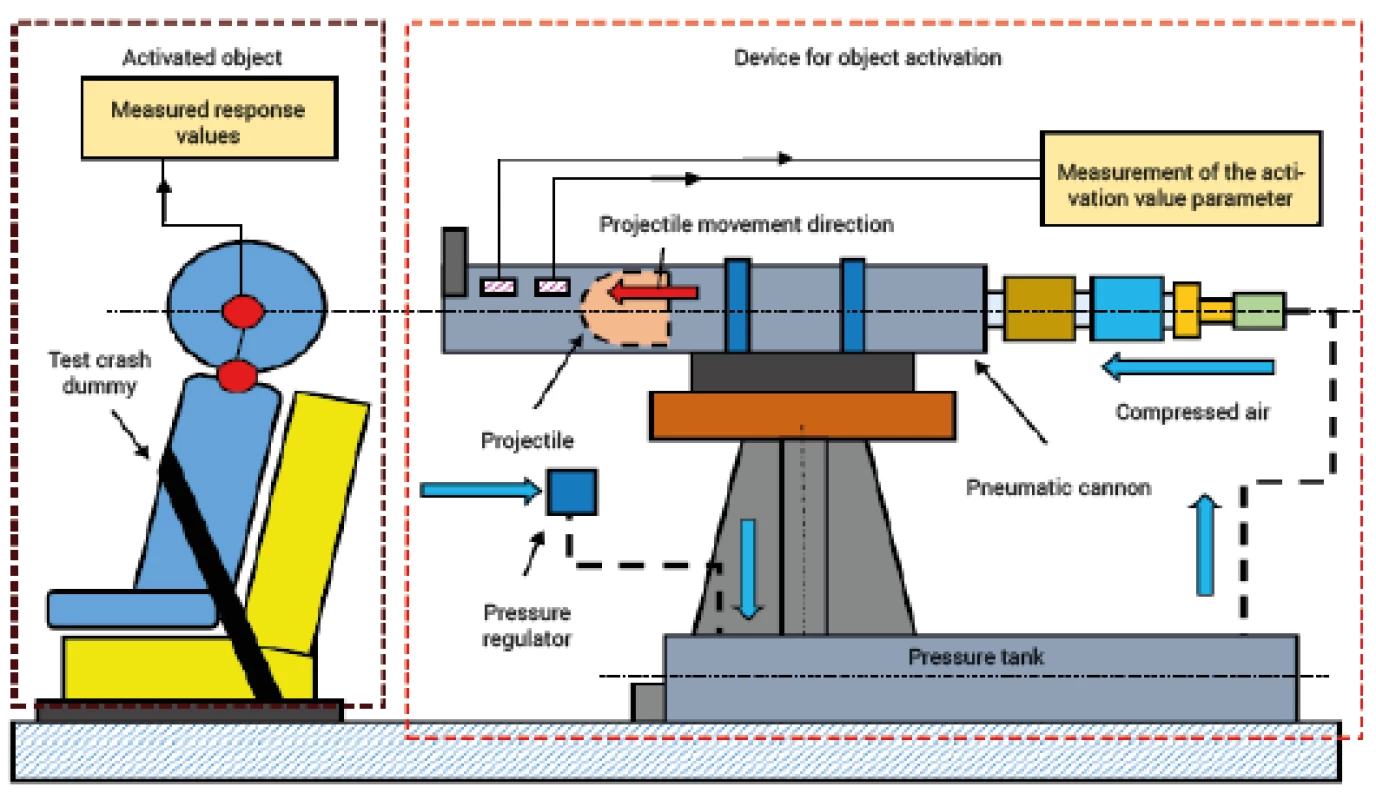
Projectile velocity evaluation
The projectile velocity evaluation and calculation was carried out in the following manner and with these parameters depending on the set pressure (with a step of 0.5 bar in the range of 1 bar to a maximum of 7 bar - range selected with respect to the Hybrid III dummy‘s „optimum“ head response) via a control valve:
- The fly-through time measurement was determined using a signal from optical gates that are positioned at a constant distance of 100 mm apart.
- The sampling frequency set for optical gate signal measurement was set at 10 kHz.
- Time difference is read from the charts of time dependence of the electrical signal from the optical gates monitoring the projectile flow-through at the muzzle opening and the velocity of the projectile is calculated using the formula 1.
Hybrid III crash test dummy head response evaluation
The evaluation of the head response in terms of its acceleration parameters and the subsequent calculation of the HIC criteria was carried out in the following manner and with the following parameters:
- The Hybrid III crash test dummy head response was measured by a three-axis (measurement in all three mutually orthogonal axes simultaneously) piezoelectric accelerometer positioned approximately in the centre of gravity of the head.
- Data related to the head response was saved to a measuring computer at a sampling frequency of 10 kHz using a DAS (Data Aquisition System).
- Measured data was edited (signal shortening - deletion of unnecessary sections) with respect to the volume of data files and the area of interest in the NI DIAdem software. The basic module of this software for data processing and analysis was used.
- The edited data were subjected to CFC 1000 filtering. This filter is specially designed for signals with a sampling frequency of 10 kHz.
- The resulting acceleration - the resulting vector - was calculated from the edited and filtered data.
- In the final phase, the HIC criterion was calculated from the edited and filtered data for both the maximum acceleration component in the direction of hybrid III crash test dummy head load and the resulting acceleration component.
- The data related to the calculation of HIC criterion was compared to the values of HIC criteria, which are equal to 250 and 1000. The value of HIC criterion equal to 250 is the limit value according to the AEP-55 military standard and, in practical terms, implies a threat to a person due to insufficient concentration (strong perception disorder) after an impact of an object on its head. The value of HIC criterion equal to 1000 is life threatening and is determined by the SAE standard.
An example of a progress of the test recorded by a high speed camera for different projectile speeds is given in Figure 4.
Fig. 4. Real measurement - visual comparison of crash test dummy behavior at different projectile (impactor) speeds 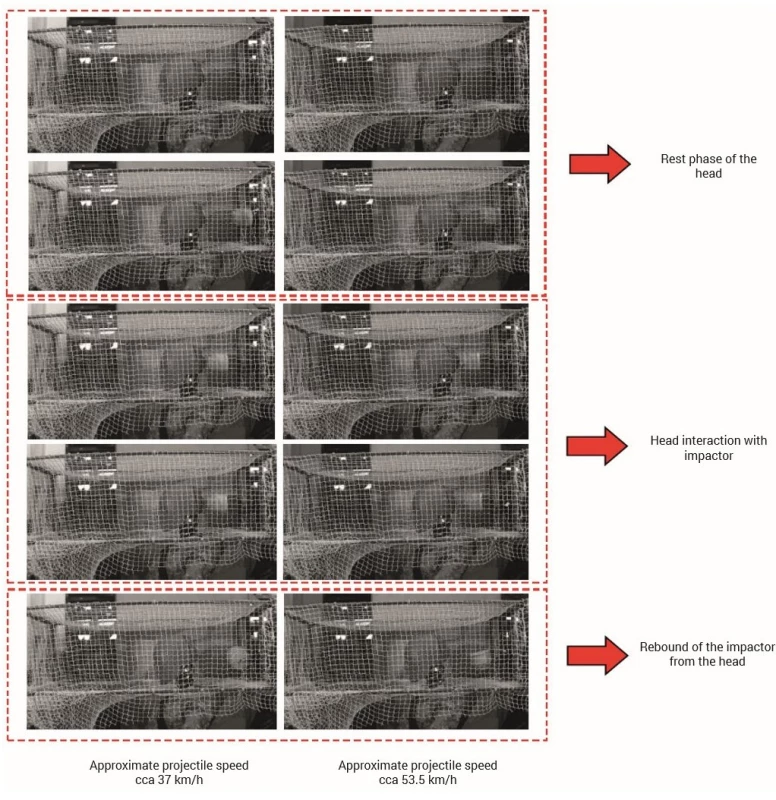
The measurement
The results below represent a part of the experiment at which a projectile with a tip of a 1 kg PET bottle. The presentation of the results for this type and weight of the projectile was chosen to clarify the possible consequences of a loosely laid (1 litre) PET bottle in the vehicle‘s free space during heavy braking or collision. A PET bottle of this and higher volume is a very common object, which is often transported for short distances in passenger cars without any secure attachment.
The graph of the set pressure on the control valve (range from 1 bar to max. 4.5 bar - step of 0.5 bar) and the velocity of the projectile fired from the pneumatic cannon (activation factor) is shown below.
Graph 2: Dependence of pressure on projectile velocity weighing 1 kg with PET bottle tip (black colour – measured data; red colour - polynomial trendline)
Graph 2. Dependence of pressure on projectile velocity weighing 1 kg with PET bottle tip (black colour – measured data; red colour - polynomial trendline) 
Measured and evaluated data for projectile with PET bottle tip (projectile weight of 1 kg)
In this case, a total of 8 measurements were taken to demonstrate the risk of injury to the human head due to interaction with a flying object weighing 1 kg with the possibility of irreversible deformation. The measurement results are shown in Table 1 and the HIC criterion calculations are shown in Table 2. In addition, a graphical representation of the data from the tables below is performed along with the evolution trend equations. These equations can be used for further calculations of values. The representation of the individual parts of the measuring chain is shown in Fig. 5 and the coordinate system for the measurement is shown in Fig. 6.
Fig. 5. Realistic representation of the projectile and the Hybrid III dummy head 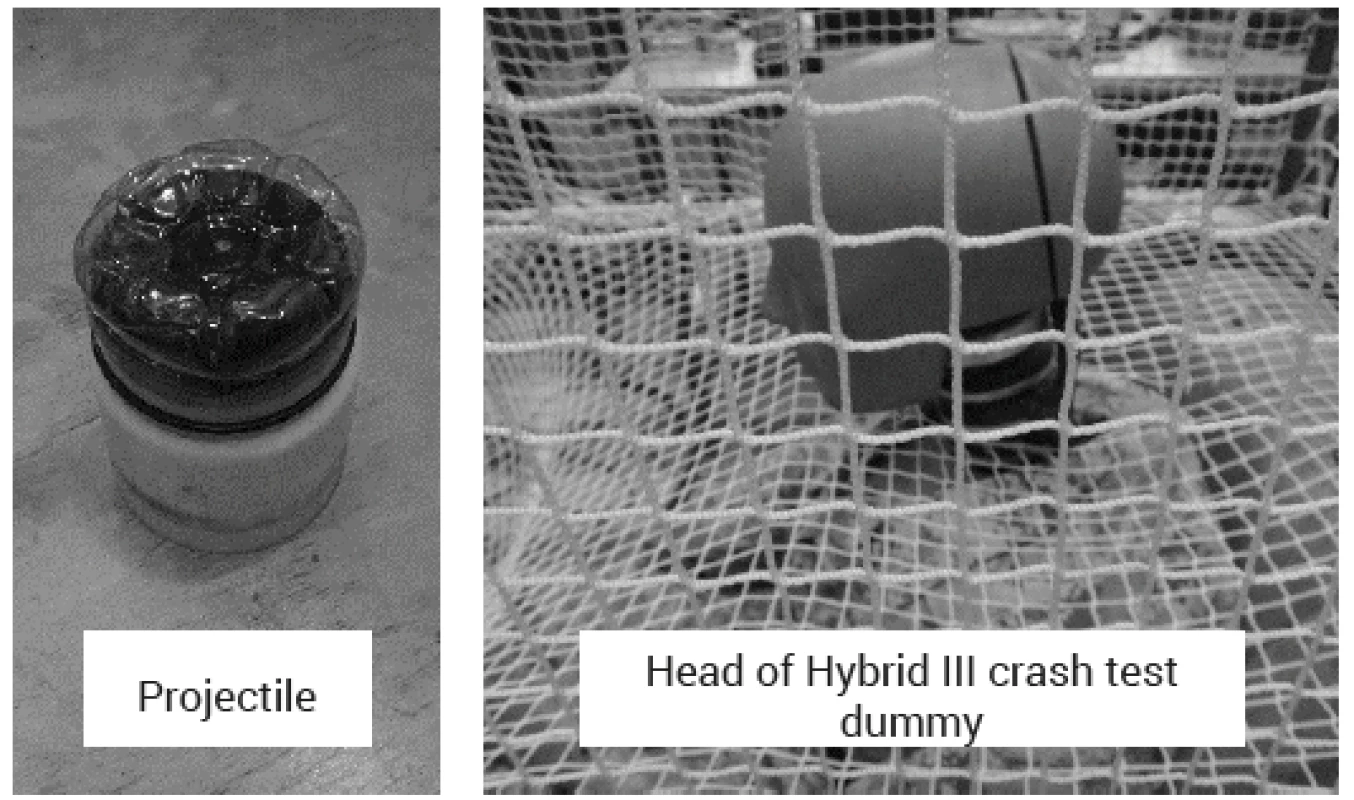
Fig. 6. Selected coordinate system for implementation and evaluation of measurements [1] ![Selected coordinate system for implementation and evaluation of measurements [1]](https://www.prolekare.cz/media/cache/resolve/media_object_image_small/media/image_pdf/deb967214bff617deaf9c445827c33f3.png)
Values of the measured and calculated acceleration
Tab. 1. Maximum acceleration values of the Hybrid III dummy head 
(orange colour – exceeding the HIC criterion limit of 250 according to AEP 55; red colour - HIC limit of 1000 exceeded) Graph 3. Example of a Hybrid III dummy head acceleration value at a projectile impact speed of 51.6 km.h-1 
Graph 4. Dependence of the resulting acceleration (resultant direction) of the Hybrid III dummy head on the impact velocity of a projectile consisting of a PET bottle weighing 1 kg - black line: Actually measured data; red line: polynomial trend line 
Values of the calculated HIC criterion
Tab. 2. HIC criterion values for Hybrid III crash test dummy 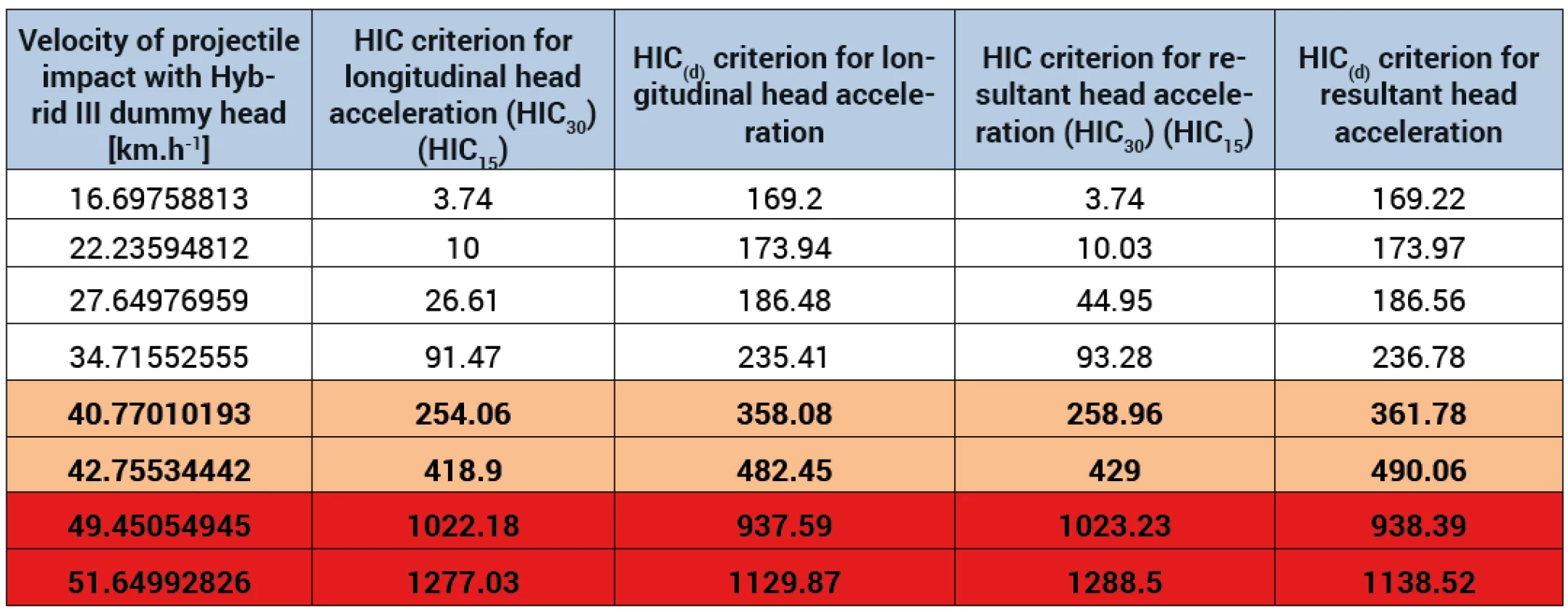
(orange colour – exceeding the HIC criterion limit of 250 according to AEP 55; red colour - HIC limit of 1000 exceeded) Graph 5. Dependence of the HIC criterion (resultant acceleration) at the Hybrid III dummy head on the impact velocity of a projectile consisting of a PET bottle weighing 1 kg - black line: Actually measured data; red line: polynomial trend line 
Graph 6. Dependence of the HIC(d) criterion (resultant acceleration) at the Hybrid III dummy head on the impact velocity of a projectile consisting of a PET bottle weighing 1 kg - black line: Actually measured data; red line: polynomial trend line 
Comparison of projectile effects
The graphs below show the course of action of projectiles with a tip of a PET bottle of 1.0 kg.
Graph 7. Graphical comparison of the value of the resulting acceleration acting on the Hybrid III dummy head (projectile tip: PET bottle - PET); (projectile weight 1 kg) 
Graph 8. Graphical comparison of the values of HIC criterion (resultant acceleration) for the the Hybrid III dummy head (projectile tip: PET bottle - PET); (projectile weight 1 kg) 
Graph 9. Graphical comparison of the values of HIC(d) criterion (resultant acceleration) for the the Hybrid III dummy head (projectile tip: PET bottle - PET); (projectile weight: 1 kg) 
Conclusion
From the presented results of the experimental measurements it is possible to clearly deduce the dependence between the rate of injury of the human head and the velocity of the projectile with the 1 kg PET bottle tip. The graphs always show the real dependencies together with the trendline, whose equation after completion can provide information about the probable future course of the situation given in the graph.
The graphs 7, 8, 9 show dependencies for the projectile with a PET bottle tip (PET – identification in graphs) with a weight of 1 kg. When evaluating in accordance with the HIC, resp. HIC(d)it is apparent that the critical velocity for a projectile weight of 1 kg is about 50 km.h-1. The momentum of the object rises with the increasing weight and velocity of the moving object (projectile), and as the measurements show, the risk of injury or fatal injury when interacting with an adult‘s head increases almost exponentially.
The results presented are applicable to an average adult, as determined by the Hybrid III crash test dummy used. The results show what speed can be dangerous in relation to the weight of a loosely placed object when a vehicle collides. Objects with a relatively low weight can cause serious injuries to adults in low-speed collisions, i.e. speeds comparable to those normally achieved in the city.
Ing. Zdeněk Krobot, Ph.D.
Zdroje
- Crash Analysis Criteria Description. Version 2.3, 2011. 113 s. online: www.mdvfs.de
- First Technology Safety Systems. Inc. 78051-9901. User Manual HIII-50th FAA Male Rev A, 2009.
Štítky
Chirurgie všeobecná Traumatologie Urgentní medicína
Článek Medial malleolar fractures
Článek vyšel v časopiseÚrazová chirurgie
Nejčtenější tento týden
2018 Číslo 3- Metamizol jako analgetikum první volby: kdy, pro koho, jak a proč?
- S MUDr. Petrou Vysočanovou o hypertenzi u diabetiků: Jak léčit skutečně účinně a bez zbytečných rizik?
- Jak souvisí postcovidový syndrom s poškozením mozku?
- Stillova choroba: vzácné a závažné systémové onemocnění
- Globální doporučené postupy pro léčbu mukormykózy zdůrazňují urgentnost zásahu
-
Všechny články tohoto čísla
- Examples of use of outpatient negative pressure therapy in chronic wound healing – a set of case reports
- Forefoot Navicular Bone Fractures - Short Communication and Case Report
- Assessment of the injuring effect of loose objects in a vehicle in a traffic accident
- Current approach to the management of forearm and elbow dislocation in children
- Medial malleolar fractures
- Effect of earlier load on healing of calcaneus fractures after stable osteosynthesis
- Úrazová chirurgie
- Archiv čísel
- Aktuální číslo
- Informace o časopisu
Nejčtenější v tomto čísle- Current approach to the management of forearm and elbow dislocation in children
- Forefoot Navicular Bone Fractures - Short Communication and Case Report
- Effect of earlier load on healing of calcaneus fractures after stable osteosynthesis
- Examples of use of outpatient negative pressure therapy in chronic wound healing – a set of case reports
Kurzy
Zvyšte si kvalifikaci online z pohodlí domova
Autoři: prof. MUDr. Vladimír Palička, CSc., Dr.h.c., doc. MUDr. Václav Vyskočil, Ph.D., MUDr. Petr Kasalický, CSc., MUDr. Jan Rosa, Ing. Pavel Havlík, Ing. Jan Adam, Hana Hejnová, DiS., Jana Křenková
Autoři: MUDr. Irena Krčmová, CSc.
Autoři: MDDr. Eleonóra Ivančová, PhD., MHA
Autoři: prof. MUDr. Eva Kubala Havrdová, DrSc.
Všechny kurzyPřihlášení#ADS_BOTTOM_SCRIPTS#Zapomenuté hesloZadejte e-mailovou adresu, se kterou jste vytvářel(a) účet, budou Vám na ni zaslány informace k nastavení nového hesla.
- Vzdělávání






